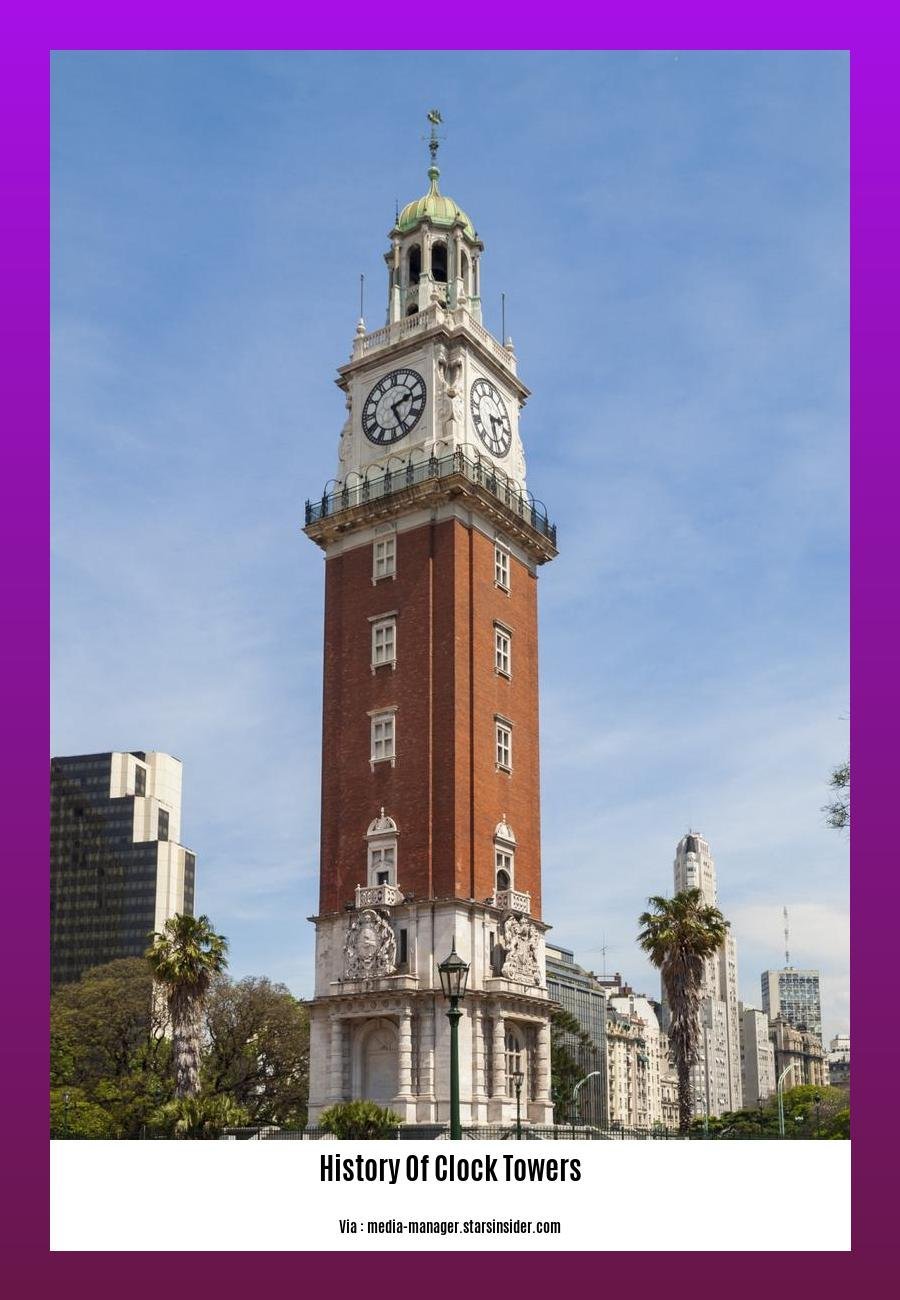Embark on a captivating journey through time as we unveil the rich history of clock towers, iconic landmarks that have stood tall, marking the passage of time for centuries. From their humble origins as rudimentary timekeepers to their transformation into architectural masterpieces, these towering structures hold stories of innovation, precision, and cultural significance. Join us as we delve into the fascinating world of clock towers, exploring their evolution, engineering marvels, and the stories they whisper to those who listen.
Key Takeaways:
Clocktowers emerged in the 11th century, serving as a means of alerting people to emergencies, significant events, and religious observances.
The Tower of the Winds in Athens stands as the earliest known clocktower, featuring eight sundials and a water clock, dating back to ancient times.
History of Clock Towers

Since their invention in the 11th century, clock towers have played a pivotal role in human history. These towering structures were initially designed to notify people of emergencies, important events, and worship times.
Early Clock Towers
The earliest known clock tower was the Tower of the Winds in Athens, built in the 1st century BC. It featured eight sundials and a water clock, showcasing the ingenuity of ancient craftsmen.
The Rise of Mechanical Clocks
The invention of mechanical clocks in the 13th century revolutionized timekeeping. These new devices were more accurate and reliable than their predecessors, leading to the construction of clock towers in major cities across Europe.
Clock Towers as Symbols of Power
As the Middle Ages progressed, clock towers became symbols of power and prestige. Many were built in prominent locations, often attached to town halls or other important buildings.
The Spread of Clock Towers
The colonization of the Americas and other parts of the world led to the spread of clock towers. They became common features in cities and towns, serving as landmarks and symbols of progress.
Clock Towers Today
Today, clock towers continue to stand as iconic structures, embodying the history and heritage of many communities. They are not only functional timepieces but also beloved landmarks that attract tourists from around the globe.
Interesting Facts About Clock Towers
The tallest clock tower in the world is the Makkah Royal Clock Tower in Saudi Arabia, standing at 601 meters (1,972 feet).
The Big Ben clock tower in London is one of the most famous clock towers in the world, renowned for its accuracy and distinctive chimes.
The Zytglogge clock tower in Bern, Switzerland, is a UNESCO World Heritage Site, known for its intricate astronomical clock.
Have you ever wondered how civil engineering shaped our modern world? Dive into the captivating history of civil engineering and discover the ingenuity and innovation behind the structures that define our landscape.
Unravel the intriguing history of Claddagh rings, a timeless symbol of love, loyalty, and friendship. Explore the origins and evolution of this iconic piece of jewelry, and discover the stories and traditions that make it a cherished keepsake.
Experience the history of classical music through the ages, from its humble beginnings to its status as a cherished art form. Delve into the lives and works of great composers, explore the development of musical genres, and discover the enduring legacy of classical music.
Cultural Symbolism: Exploring the symbolic meanings and cultural significance of clock towers, from representing civic pride to serving as gathering places for communities.

Clock towers, with their towering presence and rhythmic chimes, have long held a profound cultural and symbolic significance in societies worldwide. While their primary function remains timekeeping, these architectural marvels transcend mere practicality, embodying a rich tapestry of meanings and associations that have evolved over centuries.
Civic Pride: Beacons of Community Identity
Clock towers have often been erected as symbols of civic pride, representing the achievements, unity, and identity of a town or city. Their grandeur and elaborate designs reflect the community’s aspirations and serve as a focal point for civic celebrations and gatherings.
Gathering Places: Where Time Unites
Throughout history, clock towers have served as gathering places for communities, providing a physical and symbolic landmark for people to meet, socialize, and exchange news. The rhythmic chimes of the clock create a sense of shared experience, marking significant moments in the daily lives of the community.
Symbols of Power and Authority
Clock towers have frequently been associated with power and authority, often constructed adjacent to government buildings or town halls. Their commanding presence and elevated position symbolize the control and influence of those who govern the community.
Cultural Identity: Embracing Heritage
Clock towers have become iconic symbols of cultural identity, representing the unique heritage and traditions of a region or nation. Their distinctive architectural features, such as ornate carvings, colorful tiles, or intricate clock mechanisms, reflect the local culture and craftsmanship.
Key Takeaways:
- Clock towers embody cultural and symbolic meanings beyond timekeeping, representing civic pride, serving as gathering places, symbolizing power and authority, and embodying cultural identity.
- These majestic structures reflect the community’s aspirations and serve as focal points for civic celebrations.
- The rhythmic chimes of clock towers create a sense of shared experience, marking significant moments in the daily lives of residents.
- Clock towers often stand adjacent to government buildings, symbolizing the power and authority of those who govern the community.
- Unique architectural features of clock towers, such as carvings and tiles, reflect the local culture and craftsmanship.
References:
[1]
[2]
Technological Advancements: Highlighting key innovations in clockmaking that led to the increased accuracy and reliability of public clocks, revolutionizing the measurement of time.
The history of clock towers is tightly interwoven with the remarkable journey of clockmaking, an art that has revolutionized our perception of time and its measurement. The quest to capture and display time accurately gave rise to pivotal innovations in horological engineering, each step paving the way for the grand public clocks that grace our cityscapes today. Let’s delve into some technological milestones that shaped the landscape of timekeeping.
Key Innovations:
- Escapement Mechanism:
The escapement, an ingenious invention, regulates the release of energy from the mainspring in a controlled manner. It allows the gears to advance incrementally, ensuring a steady and precise movement of the clock’s hands.
Pendulum:
The pendulum’s rhythmic swing, first harnessed by Galileo Galilei, brought remarkable accuracy to clocks. Its steady oscillations became the heartbeat of timekeeping, minimizing deviations caused by temperature changes or wear and tear.
Balance Wheel:
- The balance wheel, a miniaturized version of the pendulum, found its place in portable timepieces like pocket watches. Its coiled spring provided the driving force, enabling accurate timekeeping on the go.
Benefits of these Innovations:
- Increased Accuracy:
These innovations dramatically improved the accuracy of clocks, reducing errors that plagued earlier timekeeping methods like sundials and water clocks.
Enhanced Reliability:
The escapement, pendulum, and balance wheel worked in harmony to create a more reliable clock mechanism, less susceptible to environmental factors.
Standardized Timekeeping:
Public clocks, with their newfound accuracy and reliability, became the standard for timekeeping in cities and towns. This fostered a sense of shared time among citizens, aiding in coordination and efficiency.
Global Impact:
- The precision of mechanical clocks enabled accurate navigation, transforming transportation and exploration. It also facilitated the synchronization of schedules across vast distances, laying the foundation for global collaboration.
Key Takeaways:
- Ancient civilizations relied on sundials, water clocks, and other rudimentary methods to measure time.
- The invention of the mechanical clock in the 13th century marked a turning point in timekeeping accuracy.
- The escapement, pendulum, and balance wheel were pivotal innovations that greatly enhanced clock precision.
- Accurate public clocks became symbols of civic pride, marking the hours for the entire community.
- The standardization of timekeeping facilitated coordination and efficiency in daily life and commerce.
- Clock towers, housing these marvels of engineering, became iconic landmarks, embodying the passage of time and human ingenuity.
[References]
– A Chronicle of Timekeeping
– Clock and Calendar History
Modern Innovations: Examining contemporary trends and advancements in clock tower design and technology, including digital displays and sustainable energy sources.
Clock towers have graced our landscapes for centuries, standing as stoic sentinels of time. But time itself is not exempt from evolution, and neither are these venerable structures. In this article, we’ll explore the fascinating world of modern clock towers and the innovations that are shaping their future.
Digital Displays: A New Era of Timekeeping
Gone are the days of dusty hands tracing mechanical faces. Digital displays have taken the clock tower into the 21st century, offering a precise and versatile way to tell time. These displays, often synchronized with atomic clocks, boast accuracy that would make a Swiss watch blush. But it’s not just about precision. Digital displays have opened up new possibilities for customization and design, allowing clock towers to become more than mere timekeepers.
Sustainable Energy: Powering Time with the Sun
In a world increasingly mindful of environmental impact, sustainability is no longer a buzzword but a necessity. Clock towers too have embraced this trend, harnessing the power of the sun to keep their gears turning. Solar panels, discreetly integrated into the structure, generate clean and renewable energy that runs the digital displays and подсветка. This marriage of ancient grandeur and modern efficiency is a testament to human ingenuity.
Smart Technology: Intelligence Meets Time
The convergence of technology is rapidly transforming industries, and clock towers are no exception. Smart technology, with its ability to collect and analyze data, is revolutionizing the way we interact with time. Sensors embedded in clock towers monitor factors like temperature, humidity, and air quality, providing valuable insights for urban planning and environmental management.
Key Takeaways:
- Digital displays have revolutionized clock towers, offering unparalleled accuracy and versatility in timekeeping.
- Sustainable energy sources, such as solar panels, are making clock towers more eco-friendly, reducing carbon emissions.
- Smart technology is transforming clock towers into data-gathering hubs, providing valuable insights for urban planning and environmental management.
References:
- How Technology Is Changing the Way We Tell Time
- The Future of Clock Towers: How Technology Is Shaping the Way We Tell Time
FAQ
Q1: When did the first clock towers emerge, and what was their primary purpose?
Q2: How did symbolic meanings of colors influence the design and aesthetics of historical clock towers?
Q3: How did the need to accurately measure time drive technological advancements in ancient societies, and what were some early chronometric tools developed?
Q4: What are the current technological advancements that are revolutionizing the field of timekeeping, and how are they impacting industries and society?
Q5: What intriguing narratives or legends surround famous clock towers, and how do they contribute to their cultural significance?
- Senior at What Age: Benefits & Eligibility Guide - March 29, 2025
- Unlocking Senior Benefits: How Old is a Senior? Your Complete Guide - March 29, 2025
- Master Russian Politeness:A Guide to Saying Please - March 29, 2025
















